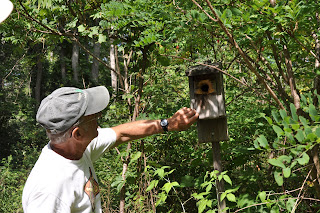Join us as Dr. Bruce Gilman, AKA The Plantman, leads us on a botanical walk along the Moody Trail in Rushville, NY on Saturday, August 6th. We will meet at 10 AM on Main Street, Rushville (CR 245 across from the Warehouse Street intersection). This is a flat walk along an old railroad bed. Everyone is welcome! Learn about the plants and habitats along the trail and about the nearly 150 years of the Canandaigua Botanical Society; the second oldest US botanical club.
*****************************************
It was a
very warm morning as 16 people appreciated the shade along much of the
Moody trail. Thanks to Steve Lewandowski for sharing the trail's
namesake, Robert Moody who was a historian of Rushville until his death
at 96 years.
This
is a partial list of the species we spotted: agrimony, American Elm
tree, Avens, bird's-foot trefoil, bitternut hickory, black locust, black
walnut, blue lubelia, burr oak, Catalpa tree, celendine, Chinkapin oak,
creeping bellflower, enchanter's nightshade, false Solomon's seal,
goldenrod, Herb Robert, hog peanut, honeysuckle, jewelweed (yellow),
Joe-pye weed, loosestrife, money wort, mugwort, ox tongue, plantain,
poison ivy, rag weed, speedwell, sumac, tall nettle, thimble weed,
Virginia knotweed, Virginia creeper, virgins bower, water plantain, white vervain, wild
blue lettuce, wild burr cucumber, wild grapes, wild parsnip.
It seems the images loaded in reverse order to how I captured them. Here is our morning in reverse. ;)
 |
Silver maple
|
.JPG) |
small monarch butterfly
|
.JPG) |
bird's foot trefoil
|
.JPG) |
clover, but we were tricked by the leaves of a neighboring plant
|
.JPG) |
yellow jewelweed
|
.JPG) |
| bitternut |
 |
bitternut hickory
|
 |
burr oak
|
Keying in a tall plant
.JPG)
.JPG) |
a second, taller one further back
|
 |
| Wild Blue Lettuce! |
 |
wild burr cucumber
|
 |
false Solomon's seal
|
 |
thimble weed
|
 |
black walnut
|
 |
black locust
|
 |
purple loosestrife
|
 |
burr cucumber flower
|
.JPG) |
hog peanut
|
 |
hog peanut flowers
|
.JPG) |
plantain / white mans' footprint
|
.JPG) |
virgins bower
|
.JPG) |
male sumac
|
.JPG) |
female sumac
|
.JPG) |
wild parsnip (to the left)
|
 |
ox tongue
|
 |
catalpa tree
|
 |
poison ivy vine growing up tree
|
 |
chinkapin oak
|
 |
blue lubelia
|
 |
joe-pye weed
|
 |
white vervain
|
.JPG) |
| speedwell |
.JPG) |
water plantain
|
 |
poison ivy
|
.JPG) |
| ragweed |
 |
| mugwort |
.JPG) |
tall nettle
|
.JPG) |
burr cucumber
|
 |
looking for snakes and other critters
|
.JPG) |
befriending snails
|
.JPG) |
herb robert
|
 |
American Elm
|
 |
American Elm
|
 |
| agrimony |
.JPG) |
| celandine |
 |
| moneywort |
.JPG) |
Virginia knotweed
|
 |
honeysuckle (introduced invasive)
|
.JPG) |
enchanter's nightshade
|
.JPG) |
creeping bellflower
|
.JPG) |
| avens |
 |
very dry creekbed
|
.JPG) |
| salamander |
 |
double-deck nests
|
.JPG)
.JPG)
.JPG)
.JPG)
.JPG)
.JPG)
.JPG)
.JPG)
.JPG)
.JPG)
.JPG)
.JPG)
.JPG)
.JPG)
.JPG)
.JPG)
.JPG)
.JPG)
.JPG)






.jpg)

.JPG)
.JPG)
.JPG)
.JPG)
.JPG)
.JPG)
.JPG)
.JPG)
.JPG)
.JPG)
.JPG)
.JPG)
.JPG)
.JPG)
.JPG)
.JPG)
.JPG)
.JPG)
.JPG)
.JPG)
.JPG)
.JPG)
.JPG)
.JPG)
.JPG)
.png)
.jpg)
.png)

.JPG)
.JPG)
.JPG)
.JPG)

.JPG)
.JPG)



.jpg)

.JPG)
.JPG)










.JPG)

.JPG)

.JPG)
.JPG)
.JPG)

.JPG)

.JPG)
.JPG)
.JPG)

.JPG)


.JPG)
.JPG)
.JPG)

.JPG)







.JPG)
.JPG)

.JPG)


.JPG)
.JPG)
.JPG)

.JPG)
.JPG)




.JPG)

.JPG)
.JPG)





.JPG)

.JPG)
.JPG)

.JPG)
.JPG)

.JPG)



.JPG)
.JPG)
